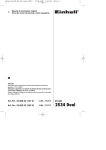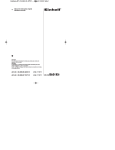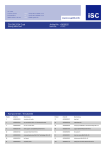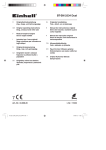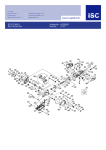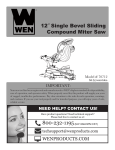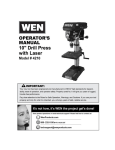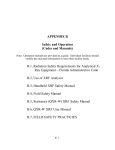Download Apex Pro 70751 Operator`s manual
Transcript
OPERATOR’S MANUAL
10" Dual Bevel Sliding
Compound Miter Saw
Model # 70751
IMPORTANT
Your new tool has been engineered and manufactured to Apex Pro’s high standards for
dependability, ease of operation, and operator safety. Properly cared for, it will give you
years of rugged, trouble-free performance.
Pay close attention to the Rules for Safe Operation, Warnings, and Cautions. If you use your
tool properly and only for what it is intended, you will enjoy years of safe, reliable service.
TABLE OF CONTENTS
Specifications ………………………………………………………………………………………
General safety rules ………………………………………………………………………………...
Safety rules for laser lights …………………………………………………………………………
Additional safety rules for miter saws ……………………………………………………………...
Know your product …………………………………………………………………………………
Operation and adjustments ………………………………………………………………………….
Unpacking …………………………………………………………………………………
Transportation ……………………………………………………………………………..
Bench mounting …………………………………………………………………………...
Release knob ………………………………………………………………………………
Slide lock ………………………………………………………………………………….
Miter table lock ……………………………………………………………………………
Bevel lock …………………………………………………………………………………
Bevel adjuster ……………………………………………………………………………..
Hold down clamp assembly ……………………………………………………………….
Spindle lock button ………………………………………………………………………..
Rotating lower blade guard ………………………………………………………………..
Dust collection bag ………………………………………………………………………..
Attaching the material support arms ………………………………………………………
Trench depth adjustment …………………………………………………………………..
Turning on and off ………………………………………………………………………..
Turning on the laser line generator ……………………………………………………….
Setting the table square with the blade ……………………………………………………
Setting the fence square with the table ……………………………………………………
Changing a blade ………………………………………………………………………….
Cross-cutting (without slide action) ………………………………………………………
Cross-cutting (with slide action) ………………………………………………………….
Bevel cut …………………………………………………………………………………..
Compound miter cut ………………………………………………………………………
Adjusting the laser lines …………………………………………………………………..
Using the laser line generator …………………………………………………………….
Maintenance ………………………………………………………………………………………..
Power cord maintenance ………………………………………………………………….
Cleaning …………………………………………………………………………………..
General inspection ………………………………………………………………………..
Exploded view and parts list ……………………………………………………………………….
Limited two years warranty…………………………………………………………………………
3
4
5
6
7
8
8
8
8
8
8
8
9
9
9
9
9
9
10
10
10
10
11
12
12
13
14
14
14
15
15
16
16
16
16
17
21
WARNINGS
It may be more difficult to see the laser line in conditions of bright sunshine and on certain surfaces.
For safe operation read instruction manual.
2
Specifications
Model Number
Input Power
No Load Speed
Blade Size
Number of teeth
Miter Table Angles
Bevel Cuts
Cutting Capacity
Straight cut
Miter cut
Bevel cut
Compound miter cut
Laser type
Laser class
Laser wave length
Laser Max. output
Weight
70751
120V, 60Hz, 15A
5000 RPM
10" x 5/8" bore
40
0°to 60°(L), 0°to 50°(R)
0°to 45°(L&R)
at 0° miter, 0° bevel: 3 3/8x12”
at 45°miter, 0°bevel: 3 3/8x8 1/2”
at 52° left miter, 0° bevel: 3 3/8x6”
at 52° right miter, 0° bevel: 3 3/8x7 5/8”
at 0° miter, 45° right bevel: 1x 12”
at 0° miter, 45° left bevel : 2x 12”
at 45° right miter, 45° right bevel: 1x8 1/2”
at 50° right miter, 45° right bevel: 1x7 5/8”
at 45° left miter, 45° left bevel: 2x8 1/2”
at 52° left miter, 45° left bevel: 2 1/4x6”
LDBXQ03B
Class IIIa
650nm
<5 mW
49.5 lbs
Included
The Apex Pro™ 10" Dual Bevel Sliding Compound Miter Saw is supplied with the following accessories as
standard:
Saw blade (installed)
Hold down clamp
6 mm hex key
2 material support arms
Dust collection bag
Instruction manual
3
General safety rules
WARNING: Read all safety warnings and all instructions. Failure to follow the warnings and
instructions may result in electric shock, fire and/or serious injury.
Save all warnings and instructions for future reference.
The term “power tool” in the warnings refers to your operated (corded) power tool.
1.
Work area safety
a.
b.
c.
2.
Electrical safety
a.
b.
c.
d.
e.
f.
3.
Keep work area clean and well lit. Cluttered or dark areas invite accidents.
Do not operate power tools in explosive atmospheres, such as in the presence of flammable liquids, gases
or dust. Power tools create sparks which may ignite the dust or fumes.
Keep children and bystanders away while operating a power tool. Distractions can cause you to lose
control.
Power tool plugs must match the outlet. Never modify the plug in any way. Do not use any adapter plugs
with earthed (grounded) power tools. Unmodified plugs and matching outlets will reduce risk of electric
shock.
Avoid body contact with earthed or grounded surfaces, such as pipes, radiators, ranges and refrigerators.
There is an increased risk of electric shock if your body is earthed or grounded.
Do not expose power tools to rain or wet conditions. Water entering a power tool will increase the risk of
electric shock.
Do not abuse the cord. Never use the cord for carrying, pulling or unplugging the power tool. Keep cord
away from heat, oil, sharp edges or moving parts. Damaged or entangled cords increase the risk of electric
shock.
When operating a power tool outdoors, use an extension cord suitable for outdoor use. Use of a cord
suitable for outdoor use reduces the risk of electric shock.
To reduce the risk of electric shock, the manufacturer recommends the use of a residual current device
with a rated residual current of 30mA or less at all times.
Personal safety
a.
b.
c.
d.
e.
f.
g.
Stay alert, watch what you are doing and use common sense when operating a power tool. Do not use a
power tool while you are tired or under the influence of drugs, alcohol or medication. A moment of
inattention while operating power tools may result in serious personal injury.
Use personal protective equipment. Always wear eye protection. Protective equipment such as dust mask,
non-skid safety shoes, hard hat, or hearing protection used for appropriate conditions will reduce personal
injuries.
Prevent unintentional starting. Ensure the switch is in the off-position before connecting to power source,
picking up or carrying the tool. Carrying power tools with your finger on the switch or energising power
tools that have the switch on invites accidents.
Remove any adjusting key or wrench before turning the power tool on. A wrench or a key left attached to
a rotating part of the power tool may result in personal injury.
Do not overreach. Keep proper footing and balance at all times. This enables better control of the power
tool in unexpected situations.
Dress properly. Do not wear loose clothing or jewellery. Keep your hair, clothing and gloves away from
moving parts. Loose clothes, jewellery or long hair can be caught in moving parts.
If devices are provided for the connection of dust extraction and collection facilities, ensure these are
connected and properly used. Use of dust collection can reduce dust-related hazards.
4
4.
Power tool use and care
a.
b.
c.
d.
e.
f.
g.
h.
i.
5.
Do not force the power tool. Use the correct power tool for your application. The correct power tool will
do the job better and safer at the rate for which it was designed.
Do not use the power tool if the switch does not turn it on and off. Any power tool that cannot be
controlled with the switch is dangerous and must be repaired.
Disconnect the plug from the power source and from the power tool before making any adjustments,
changing accessories, or storing power tools. Such preventive safety measures reduce the risk of starting
the power tool accidentally.
Store idle power tools out of the reach of children and do not allow persons unfamiliar with the power
tool or these instructions to operate the power tool. Power tools are dangerous in the hands of untrained
users.
Maintain power tools. Check for misalignment or binding of moving parts, breakage of parts and any
other condition that may affect the power tool’s operation. If damaged, have the power tool repaired
before use. Many accidents are caused by poorly maintained power tools.
Keep cutting tools sharp and clean. Properly maintained cutting tools with sharp cutting edges are less
likely to bind and are easier to control.
Use the power tool, accessories and tool bits etc. in accordance with these instructions, taking into
account the working conditions and the work to be performed. Use of the power tool for operations
different from those intended could result in a hazardous situation.
This appliance is not intended for use by persons (including children) with reduced physical, sensory or
mental capabilities, or lack of experience and knowledge, unless they have been given supervision or
instruction concerning use of the appliance by a person responsible for their safety.
Children should be supervised to ensure that they do not play with the appliance.
Service
Have your power tool serviced by a qualified repair person using only identical replacement parts. This will ensure
that the safety of the power tool is maintained.
Safety rules for laser lights
WARNING: Do not stare directly at the laser beam.
WARNING: It may be more difficult to see the laser line in conditions of bright sunshine and on certain
surfaces.
A hazard may exist if you deliberately stare into the beam, please observe all safety rules as follows:
The laser shall be used and maintained in accordance with the manufacturer’s instructions.
Never aim the beam at any person or an object other than the workpiece.
The laser beam shall not be deliberately aimed at personnel and shall be prevented from being directed
towards the eye of a person for longer than 0.25s.
Always ensure the laser beam is aimed at a sturdy workpiece without reflective surfaces. i.e. wood or rough
coated surfaces are acceptable. Bright shiny reflective sheet steel or the like is not suitable for laser use as the
reflective surface could direct the beam back at the operator.
Do not change the laser light assembly with a different type. Repairs must be carried out by the laser
manufacturer or an authorized agent.
CAUTION: Use of controls or adjustments or performance of procedures other than those specified herein may
result in hazardous radiation exposure.
5
Additional safety rules for miter saws
Ensure that the lighting is adequate.
Do not use the saw unless the guards are in place.
Do not use the saw to cut metal or masonry.
Keep the area free of tripping hazards.
Do not let anyone under 18 years operate this saw.
Always stand to one side when operating the saw.
Never use damaged or deformed saw blades. Only use sharp blades.
When cutting round wood, use clamps that prevent the workpiece from turning on both sides of the blade.
Never use your hands to remove sawdust, chips or waste close by the saw blade.
Use only blades as recommended by the manufacturer.
Do not use blades manufactured from high speed steel.
If the table insert is damaged or worn, have it replaced by an authorized service center.
Before making compound miter cuts, ensure that the work head is securely fixed in the desired position.
Rags, cloths, cord, string and the like should never be left around the work area.
Avoid cutting nails. Inspect the workpiece and remove all nails and other foreign objects before beginning
sawing.
Support the work properly.
Never reach over the blade to remove waste or cut offs.
Do not attempt to free a jammed blade before first switching off the machine.
Do not slow or stop a blade with a piece of wood. Let the blade come to rest naturally.
If you are interrupted when operating the saw, complete the process and switch off before looking up.
Periodically check that all nuts, bolts and other fasteners are properly tightened.
Always hold the saw on parts that are insulated. If you accidentally cut into hidden wiring or the saw’s own
cable, the metal parts of the saw will become ‘live’. Switch off at the mains and remove the plug immediately.
Connect the saw to a dust collection device and ensure that it is operated properly.
Wear gloves when handling saw blades.
Keep the floor area around the machine level, well maintained and free of loose materials such as wood chips
and cut-offs.
During slide cutting, always ensure that the saw blade is pushed away from the operator.
Always use stands to provide support for long work pieces that overhang the turntable.
Feed work into a blade or cutter against the direction of rotation of the blade or cutter only.
WARNING: We recommend the use of a Ground-Fault Circuit Interrupter (GFCI).
Wear goggles
Wear earmuffs
Wear a breathing mask
WARNING! For your own safety read instruction manual before operating miter saw. Wear eye
protection. Keep hands out of path of saw blade. Do not operate saw without guards in place. Do not
perform any operation freehand. Never reach around saw blade. Turn off tool and wait for saw blade to stop before
moving workpiece or changing settings. When changing the blade, replace and secure all guarding to its original
position and correctly before starting tool. Disconnect power (or unplug tool as applicable) before changing blade
or servicing. Do not expose to rain or use in damp locations. To reduce the risk of injury, return carriage to the full
rear position after each crosscut operation.
The tool must be used only for its prescribed purpose. Any use other than those mentioned in this Manual will be
considered a case of misuse. The user and not the manufacturer shall be liable for any damage or injury resulting
from such cases of misuse.
The manufacturer shall not be liable for any changes made to the tool nor for any damage resulting from such
changes.
Even when the tool is used as prescribed it is not possible to eliminate all residual risk factors. The following
hazards may arise in connection with the tool’s construction and design:
Damage to the lungs if an effective dust mask is not worn.
Damage to hearing if effective earmuffs are not worn.
6
Know your product
Before using the saw, familiarize yourself with all the operating features and safety requirements.
1. Operating handle
2. Release latch
3. 1/4” (6mm) Hex key
4. Blade bolt cover
5. Rotating blade guard
6. Laser light assembly
7. Bevel scale
8. Fence
9. Miter table
10. Miter table lock
11. Miter release lever
12. Table insert (kerf plate)
13. Miter scale
14. Side support bars (x2)
15. Side support bar location
holes (2 sets)
16. Clamp assembly lock (x2)
17. Bevel lock
18. Clamp assembly
19. Laser cover
20. Slide lock
21. Guard retraction arm
22. Dust extraction port
23. Carrying handle
24. Upper fixed blade guard
25. Spindle lock
31. 0°Bevel adjuster
32. 0°Bevel adjustment screw
33. 45°Bevel adjustment screw (left)
34. Saw arm
35. Trenching depth lock nut
26. Lock off switch
27. Laser light on/off switch
28. Switch trigger
29. Dust collection bag
30. 45°Bevel adjustment screw (right)
36. Trenching depth adjustment screw
37. Trenching stop
38. Release knob
39. Slide bars
40. Miter release latch
7
Operation and adjustments
Unpacking
Due to modern mass production techniques, it is unlikely that your Apex Pro™ Power Tool is faulty or that a part
is missing. However, if you find anything wrong, do not operate the tool until the parts have been replaced or the
fault has been rectified. Failure to do so could result in serious personal injury.
1. Remove all loose parts from the carton.
2. Remove the packing materials from around the saw.
3. Using the carrying handle (23) carefully lift the saw from the carton and place it on a level work surface.
4. The saw has been shipped with the saw arm locked in the down position. To release the saw arm, push down
on the top of the saw arm, pull on the release knob (38), rotate it 45°and let go, slowly raise the saw arm.
WARNING: Do not lift the saw while holding on to the guards. Use the carrying handle (23).
Transportation
Lift the miter saw only when the saw arm is locked in the down position, the saw is switched off and the plug is
removed from the power point.
Only lift the saw by the carrying handle (23) or outer castings. Do not lift the saw using the guard or operating
handle (1).
Bench mounting
The saw base has holes in each corner to facilitate bench mounting (Fig. 1).
1. Mount the saw to a level, horizontal bench or work table using bolts (not supplied)
and fix the saw to the bench using 4 bolts.
2. If desired, you can mount the saw to a piece of 1/2" or thicker plywood which can
then be clamped to your work support or moved to other job sites and re-clamped.
CAUTION: Make sure that the mounting surface is not warped as an uneven surface
can cause binding and inaccurate sawing.
Release knob
The release knob (38) is provided for holding the cutting head down while transporting
or storing the miter saw (Fig. 2). The saw must never be used with the release knob
locking the head down.
Slide lock
When tightened, the slide lock (20) prevents the saw head from sliding. Tighten the
slide lock during transportation (Fig. 3).
Miter table lock
The miter table lock (10) is used to lock the table at the desired miter angle (Fig. 4).
The miter saw cuts from 0°to 52.5°both left and right. To adjust the miter angle loosen
the miter table lock and depress the miter lever to allow the table to rotate, rotate to the
desired miter angle and lock the table in place. The miter table features positive click
stops at 0°, 15°, 22.5°, 31.6°and 45°for quick setting of common miter angles.
WARNING: Be sure to tighten the miter table lock before making a cut.
Failure to do so could result in the table moving during the cut and cause
serious personal injury.
8
Bevel lock
The bevel lock (17) is used to set the blade at the desired bevel angle (Fig. 5). The
miter saw bevel cuts from 0°to 45°to the left and right. To adjust the bevel angle
loosen the bevel lock and pull out the 0°bevel adjuster (31). Adjust the saw arm to the
desired bevel angle.
WARNING: Be sure to tighten the bevel lock before making a cut. Failure
to do so could result in the saw arm moving during the cut and cause
serious personal injury.
Bevel adjuster
The bevel adjuster (31) needs to be pulled out before the bevel angle can be adjusted
(Fig. 6).
To return the saw arm to the vertical (0°bevel) position, move the saw arm to the left
and push in the 0°bevel adjuster.
Return the saw blade to the vertical position; it will automatically stop at the 0°bevel
position. Tighten the bevel lock.
Hold down clamp assembly
The hold down clamp assembly (18) can be mounted to the fence, either side of the
saw blade, to suit the task at hand.
Use the clamp assembly lock (16) at the back of the fence to secure the clamp
assembly in position (Fig. 7).
Note: use only ONE clamp at a time.
Spindle lock button
The spindle lock button (25) prevents the blade in the saw from rotating (Fig. 8).
Depress and hold the spindle lock button while installing, changing, or removing the
blade.
Rotating lower blade guard
The rotating lower blade guard (5) provides protection from both sides of the blade
(Fig. 9). It retracts over the upper blade guard (24) as the saw is lowered into the
workpiece.
Dust collection bag
The dust collection bag (29) fits over the dust extraction port (22). For more efficient operation, empty the dust bag
when it is no more than half full. This allows better air flow through the bag.
9
Attaching the material support arms
The material support arms (14) help to support the material when working with long
workpieces. There are two location holes (15) for a support arm on either side of the
table. Loosen the lock knobs on the back of the base at the bottom. Ensure the support
arms are fully inserted before using them to support the workpiece (Fig. 10).
The material support arm locking knobs must be tightened to secure the support arms in
position (Fig. 11).
Trench depth adjustment
In its normal position, the trenching stop (37) permits the saw blade to cut right through a workpiece. When the
saw arm is lifted, the trenching stop can be moved to the left so that the trenching depth adjustment screw (36)
contacts the stop as the saw arm is lowered. (Fig.12).This restricts the cut to a “trench” in the workpiece. The depth
of the trench can be adjusted with the trenching depth adjustment screw (30) (Fig. 13) and locked in position with
the trenching depth lock nut (35) (Fig. 14).
Turning on and off
1.
2.
Depress lock off button (26) and pull switch trigger in (Fig. 15).
To turn the saw off release the on/off trigger switch (28).
Turning on the laser line generator
The laser line generator emits 2 intense narrow beams of pure red light to guide you as
you cut. It improves operator cutting vision, enables faster set-up, increases accuracy
and improves safety. To turn on the laser lines, press the laser light on/off switch (27)
(Fig. 16). To turn off the laser press the laser light on/off switch (27) one more time.
10
Setting the table square with the blade
1.
2.
Make sure that the electrical plug is removed from the outlet.
Push the saw arm (34) down to its lowest position and engage the release knob (6) to hold the saw arm in the
transport position.
3. Loosen the miter lock (10) (Fig. 17).
4. Rotate the table (9) until the pointer is positioned at 0º.
5. Tighten the miter lock (10).
6. Loosen the bevel lock (17) and set the saw arm (5) at 0ºbevel (the blade at 90ºto the miter table). Tighten the
bevel lock (17) (Fig. 18).
7. Place a set square against the table (9) and the flat part of the blade (Fig. 19).
Note: Make sure that the square contacts the flat part of the saw blade, not the teeth.
8. Rotate the blade by hand and check the blade-to-table alignment at several points.
9. The edge of the set square and the saw blade should be parallel.
10. If the saw blade angles away from the set square, adjust as follows.
11. Use a 13mm wrench or adjustable wrench to loosen the lock nut securing the 0°bevel adjustment screw (35)
(Fig. 20). Also, loosen the bevel lock (16).
12. Adjust the 0°bevel adjustment screw (32) with the 6mm hex key to bring the saw blade into alignment with
the square (Fig. 21).
13. Loosen the 2 Phillips head screws holding the pointer of the bevel scale (7) and adjust the position of the
pointer so that it accurately indicates zero on the scale (Fig. 22). Retighten the screw.
14. Retighten the bevel lock (17) and the lock nut securing the 0°bevel adjustment screw (32).
Note: The above procedure can also be used to check the angle of the saw blade to the table at either 45ºbevel
angle to the left or to the right. The 45°bevel adjustment screws (30 & 33) are on opposite sides of the saw arm.
You will require a 13mm wrench or adjustable wrench (not supplied) for the lock nut (Fig. 23) and the 6mm hex
key for the set screws (Fig. 24).
11
Setting the fence square with the table
1.
2.
3.
4.
5.
6.
7.
8.
9.
10.
11.
12.
13.
Make sure that the electrical plug is removed from the outlet.
Push the saw arm (34) down to its lowest position and engage the release knob (6) to hold the saw arm in the
transport position.
Loosen the miter lock (10).
Rotate the table (9) until the pointer is positioned at 0º.
Tighten the miter lock (10).
Using the 6mm hex key loosen the hex screw securing the top piece of the right hand side fence (Fig. 25) and
remove this top section.
Using the 6mm hex key provided, loosen the four screws securing the fence (8) to the base (Fig. 26).
Place a square against the fence (8) and alongside the blade (Fig. 27).
Adjust the fence (8) until it is square with the blade.
Tighten the screws securing the fence (8).
Loosen the Phillips head screw holding the pointer of the miter scale (13) and adjust it so that it accurately
indicates the zero position on the miter scale (Fig. 28).
Retighten the screw securing the miter scale pointer.
Replace the top section of the fence and secure the hex screw using the 6mm hex key.
Changing a blade
DANGER! Never try to use a blade larger than the stated capacity of the saw. It might come into contact with the
blade guards. Never use a blade that is too thick to allow the outer blade washer to engage with the flats on the
spindle. It will prevent the blade screw from properly securing the blade on the spindle. Do not use the saw to cut
metal or masonry. Ensure that any spacers and spindle rings that may be required suit the spindle and the blade
fitted.
1. Make sure that the electrical plug is removed from the power source.
2. Push down on the operating handle (1) and pull the release knob (38) to disengage the saw arm (34). The
release knob (38) can be turned so that it is held in the retracted position (Fig. 29).
3. Raise the saw arm (34) to its highest position.
4. Using a Phillips head screwdriver loosen and remove the screw that secures the guard retraction arm (21) to
the rotating blade guard (Fig 30).
5. Using a Phillips head screwdriver loosen (Fig. 31) and remove the screw that secures the blade bolt cover (4).
6. Pull the rotating blade guard (5) down then swing it up together with the blade bolt cover (4). When the
rotating blade guard (5) is positioned over the upper fixed blade guard (24) it is possible to access the blade
bolt (Fig. 32).
12
7.
Hold the rotating guard (5) up and press the spindle lock button (25) (Fig. 33).
Rotate the blade until the spindle locks.
8. Use the 6mm hex key provided to loosen and remove the blade bolt. (Loosen in a
clockwise direction as the blade screw has a left hand thread) (Fig. 34).
9. Remove the flat washer and outer blade washer and the blade.
10. Wipe a drop of oil onto the inner blade washer and the outer blade washer where
they contact the blade.
11. Fit the new blade onto the spindle taking care that the inner blade washer sits
behind the blade (Fig. 35).
CAUTION: To ensure correct blade rotation, always install the blade with the blade
teeth and the arrow printed on the side of the blade pointing down. The direction of
blade rotation is also stamped with an arrow on the upper blade guard.
12. Replace the outer blade washer (Fig. 36).
13. Depress the spindle lock button (25) and replace the flat washer and blade bolt.
14. Use the 6mm hex key to tighten the blade bolt securely (tighten in an anticlockwise direction).
15. Lower the blade guard, hold the rotating lower blade guard (5) and blade bolt
cover (4) in position and tighten the fixing screw (Fig. 37).
16. Replace the guard retraction arm and secure onto the rotating blade guard (Fig 38).
17. Check that the blade guard operates correctly and covers the blade as the saw arm is lowered.
18. Connect the saw to the power supply and run the blade to make certain that it is operating correctly.
Cross-cutting (without slide action)
When cutting a narrow piece of wood it is not necessary to use the slide mechanism. In these cases ensure that the
slide lock (20) is screwed down to prevent the saw arm from sliding. A crosscut is made
by cutting across the grain of the workpiece. A 90ºcrosscut is made with the miter table
set at 0º(Fig. 39). Miter crosscuts are made with the table set at some angle other than
zero.
1. Pull on the release knob (38) and lift the saw arm (34) to its full height.
2. Loosen the miter lock (10).
3. Rotate the miter table (9) until the pointer aligns with the desired angle.
4. Retighten the miter lock (10).
WARNING: Be sure to tighten the miter lock before making a cut. Failure to do so
could result in the table moving during the cut and cause serious personal injury.
5. Place the workpiece flat on the table with one edge securely against the fence (8).
If the board is warped, place the convex side against the fence. If the concave side
is placed against the fence, the board could break and jam the blade.
6. When cutting long pieces of lumber, support the opposite end of the lumber with
the material support arms, a roller stand or a work surface that is level with the saw
table.
7. Use the hold down clamp assembly (18) to secure the workpiece wherever possible.
8. It is possible to remove the hold down clamp assembly (18) by loosening the hold
down clamp assembly lock (16) and moving it to the other side of the table. Make sure the hold down clamp
assembly lock is tight before using the hold down clamp (Fig. 40). Never use more than ONE hold down
clamp.
9. Before turning on the saw, perform a dry run of the cutting operation to check that there are no problems.
13
10. Hold the operating handle (1) firmly, depress lock off button (25) and squeeze the
switch trigger (28) (Fig. 41). Allow the blade to reach maximum speed and slowly
lower the blade into and through the workpiece.
11. Release the switch trigger (28) and allow the saw blade to stop rotating before
raising the blade out of the workpiece. Wait until the blade stops before removing
the workpiece.
Cross-cutting (with slide action)
When cutting wide workpieces, first unscrew the slide lock (20).
1. Pull on the release knob (38), raise the saw arm (34) to its highest position and slide
it towards you (Fig. 42).
2. Hold the handle firmly and squeeze the switch trigger (28). Allow the blade to
reach maximum speed.
3. Slowly lower the blade into the workpiece and slide it away from you at the same
time until the workpiece is cut.
4. Release the switch trigger (28) and allow the saw blade to stop rotating before
raising the blade out of the workpiece. Wait until the blade stops before removing
the workpiece.
Bevel cut
A bevel cut is made by cutting across the grain of the workpiece with the blade angled
to the fence and miter table. The miter table is set at the zero degree position and the
blade set at an angle between 0ºand 45º(Fig. 43).
Use the slide action when cutting wide workpieces.
1. Pull on the release knob (38) and lift the saw arm to its full height.
2. Loosen the miter lock (10).
3. Rotate the miter table (9) until the pointer aligns with zero on the miter scale (13).
4. Retighten the miter lock (10).
WARNING: Be sure to tighten the miter lock before making a cut. Failure to do so could result in the table
moving during the cut, causing serious personal injury.
5. Loosen the bevel lock (17) and pull out the 0ºbevel adjuster. Move the saw arm (34) to the left or right to the
desired bevel angle (between 0ºand 45º). Tighten the bevel lock (17).
6. Place the workpiece flat on the table with one edge securely against the fence (8). If the board is warped, place
the convex side against the fence. If the concave side is placed against the fence, the board could break and
jam the blade.
7. When cutting long pieces of lumber, support the opposite end of the lumber with the material support arms, a
roller stand or a work surface that is level with the saw table.
8. Use the hold down clamp assembly (18) to secure the workpiece wherever possible.
9. It is possible to remove the hold down clamp assembly (18) by loosening the clamp assembly lock (16) and
moving it to the other side of the table. Make sure the hold down clamp assembly lock is tight before using the
hold down clamp.
10. Before turning on the saw, perform a dry run of the cutting operation to check that there are no problems.
11. Hold the operating handle (1) firmly and squeeze the switch trigger (28). Allow the blade to reach maximum
speed.
12. Press the release latch (2) and slowly lower the blade into and through the workpiece.
13. Release the switch trigger (28) and allow the saw blade to stop rotating before raising the blade out of the
workpiece. Wait until the blade stops before removing the workpiece.
Compound miter cut
A compound miter cut involves using a miter angle and a bevel angle at the same time
(Fig. 44). It is used in making picture frames, to cut mouldings, making boxes with
sloping sides and for roof framing. Always make a test cut on a piece of scrap wood
before cutting into the good material.
Use the slide action when cutting wide workpieces.
1. Pull on the release knob (38) and lift the saw arm to its full height.
2. Loosen the miter lock (10).
14
3. Rotate the miter table (9) until the pointer aligns with the desired angle on the miter scale (13).
4. Retighten the miter lock (10).
WARNING: Be sure to tighten the miter lock before making a cut. Failure to do so could result in the table
moving during the cut, causing serious personal injury.
5. Loosen the bevel lock (17) and pull out the 0ºbevel adjuster (31) and move the saw arm (34) to the left or
right to the desired bevel angle (between 0ºand 45º). Tighten the bevel lock (17).
6. Place the workpiece flat on the table with one edge securely against the fence (8). If the board is warped, place
the convex side against the fence. If the concave side is placed against the fence, the board could break and
jam the blade.
7. When cutting long pieces of timber, support the opposite end of the timber with the side bars (14), a roller
stand or a work surface that is level with the saw table.
8. Use the clamp assembly (18) to secure the workpiece wherever possible. Never use more than ONE clamp.
9. It is possible to remove the clamp assembly (18) by loosening the clamp assembly lock (16) and moving it to
the other side of the table. Make sure the clamp assembly lock is tight before using the clamp.
10. Before turning on the saw, perform a dry run of the cutting operation to check that there are no problems.
11. Hold the operating handle (1) firmly and squeeze the switch trigger (28). Allow the blade to reach maximum
speed and slowly lower the blade into and through the workpiece.
12. Release the switch trigger (28) and allow the saw blade to stop rotating before raising the blade out of the
workpiece. Wait until the blade stops before removing the workpiece.
Adjusting the laser line
The laser is factory set to the center of the blade width. To adjust the position of the laser,
proceed as follows:
1. Remove the laser cover by pulling it towards you.
2. Switch on the laser light with the on/off switch (27) (Fig. 45).
3. Using a Phillips head screwdriver (not supplied), adjust the position of the laser line
by turning the laser pitch control (Fig. 46).
4. Adjust until the laser hits the centre of the blade.
5. Switch off the laser light.
Using the laser line generator
WARNINGS:
Do not stare directly at the laser beam.
Never aim the beam at any person or an object other than the workpiece.
Do not deliberately aim the beam at personnel and ensure that it is not directed towards
the eye of a person for longer than 0.25s.
Always ensure the laser beam is aimed at a sturdy workpiece without reflective surfaces.
Wood or rough coated surfaces are acceptable. Bright shiny reflective surfaces are not suitable for laser use as the
reflective surface could direct the beam back at the operator.
Always remember to switch off the laser on/off switch (27) after finishing a job. Only turn the laser beam on when
the workpiece is on the miter saw table.
1. Mark the line of the cut on the workpiece.
2. Adjust the angle of miter and bevel of the cut as required.
3. Switch on the laser light on/off switch (27).
4. Clamp the workpiece in position using the laser line to align the blade with the pencil mark on the workpiece.
5. Plug in the machine and start the motor.
6. When the blade is at its maximum speed (approximately 2 seconds), lower the blade through the workpiece.
7. After completing the cut, switch off the laser light on/off switch (27).
8. After each use, clean the laser light assembly (6) as described below:
Switch off the laser light switch (27) and then remove the plug from the power point.
With the saw arm (34) in the raised position, use a soft brush to dust away the sawdust build-up around
the assembly.
Note: Wear eye protection while brushing the dust away.
15
Maintenance
WARNING: Always ensure that the tool is switched off and the plug is removed from the outlet before making
any adjustments or maintenance procedures.
Any damage to this tool should be repaired and carefully inspected before use, by qualified repair personnel.
Have your power tool serviced by a qualified repair person using only identical replacement parts. This will
ensure that the safety of the power tool is maintained.
Great Lakes Technologies, LLC will not be responsible for any damage or injury caused by unauthorized
repair or mishandling of the tool.
Power cord maintenance
If the supply cord needs replacing, the task must be carried out by the manufacturer, the manufacturer’s agent, or
an authorized service centre in order to avoid a safety hazard.
Cleaning
1. Keep the tool’s air vents unclogged and clean at all times.
2. Remove dust and dirt regularly. Cleaning is best done with a soft brush or a rag.
3. Re-lubricate all moving parts at regular intervals.
4. Never use caustic agents to clean plastic parts.
CAUTION: Do not use cleaning agents to clean the plastic parts of the saw. A mild detergent on a damp cloth is
recommended.
General inspection
Regularly check that all screws are tight.
They may vibrate loose over time.
16
Exploded view and parts list
17
Part #
1
2
4
5
6
7
8
9
10
11
12
13
14
15
16
17
18
19
20
21
22
23
24
25
26
27
28
29
30
31
32
33
34
35
36
37
38
39
40
41
42
43
44
45
46
Stock #
70751-001
70751-002
70751-004
70751-005
70751-006
70751-007
70751-008
70751-009
70751-010
70751-011
70751-012
70751-013
70751-014
70751-015
70751-016
70751-017
70751-018
70751-019
70751-020
70751-021
70751-022
70751-023
70751-024
70751-025
70751-026
70751-027
70751-028
70751-029
70751-030
70751-031
70751-032
70751-033
70751-034
70751-035
70751-036
70751-037
70751-038
70751-039
70751-040
70751-041
70751-042
70751-043
70751-044
70751-045
70751-046
Description
Screw
Motor cover
Screw
Spring washer
Washer
Motor housing
Screw
Brush holder
Brush
Brush spring
Rubber boot
Bearing
Armature
C clip
Stator
Washer
Spring washer
Screw
Fan baffle
Screw
Spring washer
Bearing cover
Bearing
C clip
Screw
Spring washer
Washer
Carry handle
Screw
Screw
Screw
Spring washer
Nut
Depth adjustment screw
Screw
Nut
Linkage speedup block
Taper lock washer
Screw
Rocker arm
Screw
Exhaust port
Dust collection bag
Washer
Spring washer
Part #
47
48
49
50
51
53
54
55
56
57
58
60
61
62
63
64
65
66
67
68
69
70
71
72
73
74
75
76
77
78
79
80
81
82
83
84
85
86
87
88
89
90
91
92
93
18
Stock #
70751-047
70751-048
70751-049
70751-050
70751-051
70751-053
70751-054
70751-055
70751-056
70751-057
70751-058
70751-060
70751-061
70751-062
70751-063
70751-064
70751-065
70751-066
70751-067
70751-068
70751-069
70751-070
70751-071
70751-072
70751-073
70751-074
70751-075
70751-076
70751-077
70751-078
70751-079
70751-080
70751-081
70751-082
70751-083
70751-084
70751-085
70751-086
70751-087
70751-088
70751-089
70751-090
70751-091
70751-092
70751-093
Description
Screw
Cord protector
Trigger
Cold clamp
Screw
Binding post
Transformer
Upper handle
Lucidity plate
Laser switch button
Laser switch
Switch
Switch lock button
Lock button spring
Screw
Lower handle
Spring washer
Screw
Fixed guard
Bearing
C clip
Gear
Screw
Bearing
Spring washer
Screw
Gear case cover
Spindle
Key
Inner flange
Blade
Outer flange
Arbor bolt
Screw
Spring washer
Plate guarding(big)
Plate guarding(small)
Moving guard plate
Big washer
Screw
Torsion spring
Special screw
Rivet
Cast centre
Moving guard
Part #
95
96
97
98
99
100
101
102
103
104
105
106
107
108
109
110
111
112
113
114
115
116
117
118
119
120
121
122
123
124
125
126
127
128
129
130
131
132
133
134
135
136
137
138
139
Stock #
70751-095
70751-096
70751-097
70751-098
70751-099
70751-100
70751-101
70751-102
70751-103
70751-104
70751-105
70751-106
70751-107
70751-108
70751-109
70751-110
70751-111
70751-112
70751-113
70751-114
70751-115
70751-116
70751-117
70751-118
70751-119
70751-120
70751-121
70751-122
70751-123
70751-124
70751-125
70751-126
70751-127
70751-128
70751-129
70751-130
70751-131
70751-132
70751-133
70751-134
70751-135
70751-136
70751-137
70751-138
70751-139
Description
Sunk screw
Locknut
Shield lock piece
Spring
Shield lock sheet
Washer
Screw
Screw
Back guard safety
E clip
Gear lock pin spring
Gear lock pin
Shoulder Screw
Linkage
Shoulder Screw
Laser window
Laser case
Screw
Laser
Screw
Dual laser carrier
Screw
Laser fixed plate
Bracket
Big screw
Pivot shaft
Bearing
Special screw
Linkage support
Shoulder Screw
Bearing cover
Spring washer
Screw
Rubber pole
Lock pin
Lock pin spring
Lock pin cap
Rolled pin
Trench depth bracket
Wave washer
Shoulder Screw
Socket head screw
Spring washer
Socket head screw
Spring sleeve
Part #
140
141
142
143
144
145
146
147
148
149
150
151
152
153
154
155
156
157
158
159
160
161
162
163
164
165
166
167
168
169
170
171
172
173
174
175
176
177
178
179
180
181
182
183
184
19
Stock #
70751-140
70751-141
70751-142
70751-143
70751-144
70751-145
70751-146
70751-147
70751-148
70751-149
70751-150
70751-151
70751-152
70751-153
70751-154
70751-155
70751-156
70751-157
70751-158
70751-159
70751-160
70751-161
70751-162
70751-163
70751-164
70751-165
70751-166
70751-167
70751-168
70751-169
70751-170
70751-171
70751-172
70751-173
70751-174
70751-175
70751-176
70751-177
70751-178
70751-179
70751-180
70751-181
70751-182
70751-183
70751-184
Description
Big torsion spring
Spring washer
Screw
Screw
Spring washer
Bevel pointer(left)
Arm
Linear bearing
Slide
Slide end cap
Slide end cap carry handle
Spring washer
Socket head screw
Linear bearing
Screw
Spring washer
Washer
Bevel lock handle
Washer
Bevel lock bolt
Locknut
Washer
Long knob
Screw
Hex grub screw
Washer
Lever
Nut
Socket head screw
Bevel pointer(right)
Double stud
Straight cut setting pin
Sunk screw
Safety cover
Bevel scale
Nut
Socket head screw
Locknut
Washer
Screw
Cutting insert
Spring
Detent pole
Socket head screw
Turntable bolt
Part #
185
186
187
188
189
190
191
192
193
194
195
196
200
201
202
203
204
205
206
207
208
209
210
211
213
214
215
221
222
223
Stock #
70751-185
70751-186
70751-187
70751-188
70751-189
70751-190
70751-191
70751-192
70751-193
70751-194
70751-195
70751-196
70751-200
70751-201
70751-202
70751-203
70751-204
70751-205
70751-206
70751-207
70751-208
70751-209
70751-210
70751-211
70751-213
70751-214
70751-215
70751-221
70751-222
70751-223
Description
Turntable bolt cover
Spring washer
Screw
Miter pointer
Spring washer
Screw
Long knob
Turntable
Lock Boot
Support bar
Spring washer
Screw
Lock bolt
Lock Handle
Base
Rubber foot
Shoulder Screw
Slide table(right)
Fence
Screw
Long knob
Hex grub screw
Left slide fence
Right slide fence
Clamp
Support arm
Workpiece knob
Support pole
Front guard safety
Power cord
20
Limited two years warranty
APEX PRO Products is committed to build tools that are dependable for years. Our warranties are consistent with this
commitment and our dedication to quality
LIMITED WARRANTY OF APEX PRO CONSUMER POWER TOOLS PRODUCTS FOR HOME USE
GREAT LAKES TECHNOLOGIES, LLC ("Seller") warrants to the original purchaser only, that all APEX PRO consumer
power tools will be free from defects in material or workmanship for a period of two (2) years from date of purchase. Ninety
days for all APEX PRO products, if the tool is used for professional use.
SELLER'S SOLE OBLIGATION AND YOUR EXCLUSIVE REMEDY under this Limited Warranty and, to the extent
permitted by law, any warranty or condition implied by law, shall be the repair or replacement of parts, without charge, which
are defective in material or workmanship and which have not been misused, carelessly handled, or misrepaired by persons other
than Seller or Authorized Service Center. To make a claim under this Limited Warranty, please contact us at 1-800-232-1195 or
write to us at APEX PRO Products, 1675 Holmes Road, Elgin, IL 60123. To acquire service, you will have to provide proof of
purchase and may be asked to ship the tool back to us freight prepaid.
THIS LIMITED WARRANTY DOES NOT APPLY TO CIRCULAR SAW BLADES AND MOTOR BRUSHES.
ANY IMPLIED WARRANTIES SHALL BE LIMITED IN DURATION TO TWO (2) YEARS FROM DATE OF
PURCHASE. SOME STATES IN THE U.S., SOME CANADIAN PROVINCES DO NOT ALLOW LIMITATIONS ON
HOW LONG AN IMPLIED WARRANTY LASTS, SO THE ABOVE LIMITATION MAY NOT APPLY TO YOU.
IN NO EVENT SHALL SELLER BE LIABLE FOR ANY INCIDENTAL OR CONSEQUENTIAL DAMAGES
(INCLUDING BUT NOT LIMITED TO LIABILITY FOR LOSS OF PROFITS) ARISING FROM THE SALE OR USE OF
THIS PRODUCT. SOME STATES IN THE U.S. AND SOME CANADIAN PROVINCES DO NOT ALLOW THE
EXCLUSION OR LIMITATION OF INCIDENTAL OR CONSEQUENTIAL DAMAGES, SO THE ABOVE LIMITATION
OR EXCLUSION MAY NOT APPLY TO YOU.
THIS LIMITED WARRANTY GIVES YOU SPECIFIC LEGAL RIGHTS, AND YOU MAY ALSO HAVE OTHER RIGHTS
WHICH VARY FROM STATE TO STATE IN THE U.S., PROVINCE TO PROVINCE IN CANADA AND FROM
COUNTRY TO COUNTRY.
THIS LIMITED WARRANTY APPLIES ONLY TO PORTABLE ELECTRIC TOOLS, BENCH POWER TOOLS,
OUTDOOR POWER EQUIPMENT AND PNUMATIC TOOLS SOLD WITHIN THE UNITED STATES OF AMERICA,
CANADA AND THE COMMONWEALTH OF PUERTO RICO. FOR WARRANTY COVERAGE WITHIN OTHER
COUNTRIES, CONTACT THE APEX PRO CUSTOMER SUPPORT.
21





















